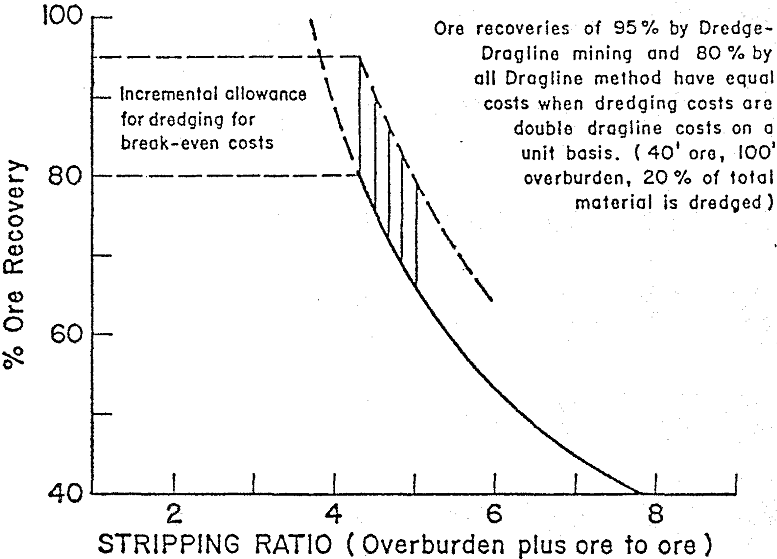Texasgulf’s Lee Creek Mine in Eastern North Carolina is using a combination Dredge-Dragline method for mining deep phosphate ore at a rate of 3.5 million tons per year. The matrix is thick, uniform in grade, and is processed into agricultural products. As in many other good mineral deposits, there are tough obstacles to overcome in recovering the ore.
The dragline operators became skilled at selecting overburden for building the spoil piles. In spite of all efforts to improve the situation, the unstable spoils would very frequently cover up the ore resulting in low ore recoveries, low production rates, and high mining costs.
Next, bucket wheel excavators were carefully reviewed. The casting wheel units with extra long booms that could reach over 500 feet beyond the high wall could handle the material, but interference with a bucket wheel excavator, two draglines, ore piles, pipelines, and slurry equipment on a narrow bench ruled the method unfeasible.
Bucket wheel excavators using conveyors and stackers were ruled out for the same reason that haulage equipment was ruled out and that was that the average spoiled overburden would not support a stacker.
The hydraulic dredging method of removing the top 40 feet of all dry material was really decided upon by the elimination of dry mining methods. Factors leading to this decision were:
- It had been proven that a dredge could successfully excavate this section of material since a contract dredge was used in 1966 to open the original development cut. Eight million cubic yards of material were dredged and used to build up a base for a 700 acre plant in this low-lying swampy area.
- The costs of dredging were acceptable.
- The ore bed is continuous and property boundaries were acceptable for developing large blocks.
- A large source of fresh water was available from the 60 million gallon per day depressurizing system after being cycled through the various plant facilities.
- A large mined-over area from ten years of mining was available to accept the fill.
- Fines in the overburden section were within acceptable limits and of a type that would allow quick clarification for water recycling.
- The terrain is flat and water is easily recycled by canals with a minimum of pumping.
- Water from the completed ponds can be discharged to the estuary nearby.
- The system is environmentally acceptable.
The conversion to the dredge method of removing the problem portion of the overburden has not been without major problems. It must be emphasized that dredging is not used purely to supplement the draglines in stripping overburden. It is used out of necessity to remove cohesionless material that cannot be successfully handled by open cast methods.


